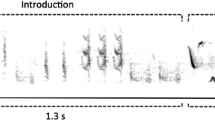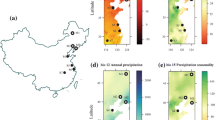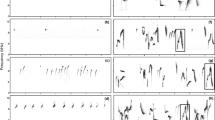Abstract
Decades of research on geographic variation of birdsong have provided evidence that passerine vocalization often diverges among populations. We asked whether even songs so simple that they superficially resemble stridulating insects vary geographically. We focused on two closely related species of the genus Locustella, the River Warbler (L. fluviatilis) and the Grasshopper Warbler (L. naevia). At four Central European localities separated by 85–380 km, we recorded 62 River Warbler males, and at three of these sites, we also recorded 32 coexisting Grasshopper Warbler males. We hypothesized to observe differences among geographically distant populations in both species. However, only the song of River Warbler diverged among the localities in structural and quantitative parameters, especially in the number, frequency and position of high-amplitude notes within the repeated syllables. Discriminant analysis successfully classified 80% of all River Warbler males to their respective population, in agreement with our subjective classification of songs into several categories. In contrast, the populations of Grasshopper Warbler at the same spatial scale could not be differentiated either by visual inspection or by any of the measured song characteristics. Further comparison with spectrograms available from the European range of both species supported these patterns also on a larger geographical scale, with additional distinct River Warbler song types observed out of our study region, but similarly looking Grasshopper Warbler song types distributed across the continent. Different patterns of song geographic variation in the two coexisting, closely related species highlight species-specific traits that contribute to song divergence and imply the great diversity in singing behaviour among songbirds.
Zusammenfassung
Unterschiedliche Muster geografischer Gesangsvariation bei zwei nahe verwandten Singvogelarten mit schlichtem Gesang
Jahrzehntelange Erforschung der geografischen Variation von Vogelgesängen lieferte Belege dafür, dass sich die Lautäußerungen von Singvögeln oft zwischen Populationen unterscheiden. Wir stellten uns die Frage, ob sogar solche Gesänge geografisch variieren, die so schlicht sind, dass sie oberflächlich an stridulierende Insekten erinnern. Wir konzentrierten uns auf zwei nahe verwandte Arten der Gattung Locustella, den Schlagschwirl L. fluviatilis und den Feldschwirl L. naevia. An vier 85 bis 380 km voneinander entfernten Orten in Mitteleuropa nahmen wir 62 Schlagschwirlmännchen auf; an dreien dieser Orte machten wir außerdem Aufnahmen von 32 ebenfalls dort lebenden Feldschwirlmännchen. Wir postulierten das Auftreten von Unterschieden zwischen geografisch getrennten Populationen bei beiden Arten. Allerdings unterschieden sich nur die Gesänge des Schlagschwirls zwischen den Orten bezüglich ihrer strukturellen und quantitativen Parameter, hier besonders in Anzahl, Frequenz und Anordnung der Töne mit hoher Amplitude innerhalb der wiederholten Silben. Mittels Diskriminanzanalysen konnten erfolgreich 80% aller Schlagschwirlmännchen ihrer jeweiligen Population zugeordnet werden, was mit unserer subjektiven Einteilung der Gesänge in verschiedene Kategorien übereinstimmte. Im Gegensatz dazu gelang es weder durch visuelle Betrachtung noch mittels eines der erfassten Gesangsmerkmale, die Feldschwirlpopulationen im selben räumlichen Maßstab zu unterscheiden. Weitergehende Vergleiche mit für die europäischen Verbreitungsgebiete beider Arten verfügbaren Sonagramme bestätigten diese Muster auch für einen größeren geografischen Maßstab, das heißt außerhalb unseres Untersuchungsgebietes gab es beim Schlagschwirl weitere eindeutige Gesangsvarianten, wohingegen Feldschwirle kontinentweit ähnliche Gesangstypen zeigten. Das Auftreten verschiedener Muster der geografischen Gesangsvariation bei zwei gemeinsam vorkommenden, nahe verwandten Vogelarten unterstreicht artspezifische Merkmale, die zur Gesangsvielfalt beitragen und ist ein Zeichen der großen Diversität des Gesangsverhaltens bei Singvögeln.




Similar content being viewed by others
Availability of data and material
Analysed songs will be provided via the Journal of Ornithology sound library.
References
Alström P, Cibois A, Irestedt M, Zuccon D, Gelang M, Fjeldsa J, Andersen MJ, Moyle RG, Pasquet E, Olsson U (2018) Comprehensive molecular phylogeny of the grassbirds and allies (Locustellidae) reveals extensive non-monophyly of traditional genera, and a proposal for a new classification. Mol Phylogenet Evol 127:367–375. https://doi.org/10.1016/j.ympev.2018.03.029
Baker MC, Cunningham MA (1985) The biology of bird-song dialects. Behav Brain Sci 8:85–133. https://doi.org/10.1017/S0140525X00019750
Balaban E (1988) Cultural and genetic variation in swamp sparrows (Melospiza georgiana): I. Song variation, genetic variation, and their relationship. Behaviour 105:250–291. https://doi.org/10.1163/156853988X00052
Ballentine B, Hyman J, Nowicki S (2004) Vocal performance influences female response to male bird song: an experimental test. Behav Ecol 15:163–168. https://doi.org/10.1093/beheco/arg090
Baptista LF (1977) Geographic variation in song and dialects of the puget sound white-crowned sparrow. Condor 79:356–370. https://doi.org/10.2307/1368014
Baptista LF, King JR (1980) Geographical variation in song and song dialects of montane white-crowned sparrows. Condor 82:267–284. https://doi.org/10.2307/1367392
Becker PH (1990) Der Gesang des Feldschwirls (Locustella naevia) bei Lernentzug. Vogelwarte 35:257–267
Beecher M, Brenowitz E (2005) Functional aspects of song learning in songbirds. Trends Ecol Evol 20:143–149. https://doi.org/10.1016/j.tree.2005.01.004
Bergmann HH, Helb HW (1982) Stimmen der Vögel Europas. BLV Verlagsgesellschaft, München
Boersma P, Weenink D (2013) Praat: doing phonetics by computer [Computer program]. Version 5.3.45. Available from https://www.praat.org
Brackenbury JH (1978) A comparison of the origin and temporal arrangement of pulsed sounds in the songs of the grasshopper and sedge warblers, Locustella naevia and Acrocephalus schoenobaenus. J Zool 184:187–206. https://doi.org/10.1111/j.1469-7998.1978.tb03275.x
Branch CL, Pravosudov VV (2020) Variation in song structure along an elevation gradient in a resident songbird. Behav Ecol Sociobiol 74:1–15. https://doi.org/10.1007/s00265-019-2786-5
Briefer E, Osiejuk TS, Rybak F, Aubin T (2009) Are bird song complexity and song sharing shaped by habitat structure? An information theory and statistical approach. J Theor Biol 262:151–164. https://doi.org/10.1016/j.jtbi.2009.09.020
Bryan K, Moldenhauer R, Kroodsma DE (1987) Geographic uniformity in songs of the prothonotary warbler. Wilson Bull 99:369–376
Budka M, Mikkelsen G, Turčoková L, Fourcade Y, Dale S, Osiejuk TS (2014) Macrogeographic variation in the call of the corncrake Crex crex. J Avian Biol 45:65–74. https://doi.org/10.1111/j.1600-048X.2013.00208.x
Catchpole CK, Slater PJB (2008) Bird song: biological themes and variations, 2nd edn. Cambridge University Press, Cambridge
Cepák J, Klvaňa P, Škopek L, Schröpfer L, Jelínek M, Horák D, Formánek J, Zárybnický J (2008) Atlas migrace ptáků České a Slovenské republiky. Aventinum, Praha
Chilton G, Wiebe MO, Handford P (2002) Large-scale geographic variation in songs of gambel’s white-crowned sparrows. Condor 104:378–386. https://doi.org/10.1093/condor/104.2.378
Cramp S (ed) (1992) The birds of the western palearctic, vol VI. Oxford University Press, Oxford
Danko Š, Darolová A, Krištín A (2002) Rozšírenie vtákov na Slovensku. VEDA, Bratislava
del Hoyo J, Elliot A, Christie DA (2006) Handbook of the birds of the world, old world flycatchers to old world warblers, vol 11. Lynx Edicions, Barcelona
Diblíková L, Pipek P, Petrusek A, Svoboda J, Bílková J, Vermouzek Z, Procházka P, Petrusková T (2019) Detailed large-scale mapping of geographical variation of yellowhammer Emberiza citrinella song dialects in a citizen science project. Ibis 161:401–414. https://doi.org/10.1111/ibi.12621
Dingle C, Halfwerk W, Slabbekoorn H (2008) Habitat-dependent song divergence at subspecies level in the grey-breasted wood-wren. J Evol Biol 21:1079–1089. https://doi.org/10.1111/j.1420-9101.2008.01536.x
Edwards SV, Kingan SB, Calkins JD, Balakrishnan CN, Jennings WB, Swanson WJ, Sorenson MD (2005) Speciation in birds: genes, geography, and sexual selection. Proc Natl Acad Sci USA 102:6550–6557. https://doi.org/10.17226/11310
Ellers J, Slabbekoorn H (2003) Song divergence and male dispersal among bird populations: a spatially explicit model testing the role of vocal learning. Anim Behav 65:671–681. https://doi.org/10.1006/anbe.2003.2081
Fayet AL, Tobias JA, Hintzen RE, Seddon N (2014) Immigration and dispersal are key determinants of cultural diversity in a songbird population. Behav Ecol 25:744–753. https://doi.org/10.1093/beheco/aru047
Freeman BG, Montgomery GA (2017) Using song playback experiments to measure species recognition between geographically isolated populations: a comparison with acoustic trait analyses. Auk 134:857–870. https://doi.org/10.1642/auk-17-63.1
Gammon DE, Baker MC, Tipton JR (2005) Cultural divergence within novel song in the black-capped chickadee (Poecile atricapillus). Auk 122:853–871. https://doi.org/10.1642/0004-8038(2005)122[0853:CDWNSI]2.0.CO;2
González C, Ornelas JF (2014) Acoustic divergence with gene flow in a lekking hummingbird with complex songs. PLOS ONE 9:1–13. https://doi.org/10.1371/journal.pone.0109241
Griesmann B, Naguib M (2002) Song sharing in neighboring and non-neighboring thrush nightingales (Luscinia luscinia) and its implications for communication. Ethology 108:337–387. https://doi.org/10.1046/j.1439-0310.2002.00781.x
Handley HG, Nelson DA (2005) Ecological and phylogenetic effects on song sharing in songbirds. Ethology 111:221–238. https://doi.org/10.1111/j.1439-0310.2004.01043.x
Ippi S, Vásquez RA, Van Dongen WFD, Lazzoni I (2011) Geographical variation in the vocalizations of the suboscine thorn-tailed rayadito Aphrastura spinicauda. Ibis 153:789–805. https://doi.org/10.1111/j.1474-919X.2011.01165.x
Irwin DE (2000) Song variation in an avian ring species. Evolution 54:998–1010. https://doi.org/10.1111/j.0014-3820.2000.tb00099.x
Janes SW, Ryker L (2016) Nashville warblers (Oreothlypis ruficapilla) use a single song type in southwestern oregon with widely distributed song variants. Wilson J Ornithol 128:412–418. https://doi.org/10.1676/wils-128-02-412-418.1
Keller V, Herrando S, Voříšek P, Franch M, Kipson M, Milanesi P, Marti D, Anton M, Klvaňová A, Kalyakin MV, Bauer HG, Foppen RPB (2020) European breeding bird atlas 2 distribution abundance and change. European Bird Census Council & Lynx Edicions, Barcelona
Kennerley P, Pearson D (2010) Reed and bush warblers. Christopher Helm, London
Kroodsma DE, Byers BE, Halkin SL, Hill C, Minis D, Bolsinger JR, Dawson JA, Donelan E, Farrington J, Gill FB, Houlihan P, Innes D, Keller G, Macaulay L, Marantz CA, Ortiz J, Stoddard PK, Wilda K (1999a) Geographic variation in black-capped chickadee songs and singing behavior. Auk 116:387–402. https://doi.org/10.2307/4089373
Kroodsma DE, Liu W-C, Goodwin E, Bedell PA (1999b) The ecology of song improvisation as illustrated by north american sedge wrens. Auk 116:373–386. https://doi.org/10.2307/4089372
Lachlan RF, Ratmann O, Nowicki S (2018) Cultural conformity generates extremely stable traditions in bird song. Nat Commun 9:1–9. https://doi.org/10.1038/s41467-018-04728-1
Lahti DC, Moseley DL, Podos J (2011) A tradeoff between performance and accuracy in bird song learning. Ethology 117:802–811. https://doi.org/10.1111/j.1439-0310.2011.01930.x
Laiolo P, Tella JL (2005) Habitat fragmentation affects culture transmission: patterns of song matching in Dupont’s Lark. J Appl Ecol 42:1183–1193. https://doi.org/10.1111/j.1365-2664.2005.01093.x
Liu WC, Kroodsma DE (2006) Song learning by chipping sparrows: when, where, and from whom. Condor 108:509–517. https://doi.org/10.1016/S0252-9602(06)60076-3
MacDougall-Shackleton EA, MacDougall-Shackleton SA (2001) Cultural and genetic evolution in mountain white-crowned sparrows: song dialects are associated with population structure. Evolution 55:2568–2575. https://doi.org/10.1111/j.0014-3820.2001.tb00769.x
Mackowicz R (1989) Breeding biology of the river warbler Locustella fluviatilis (Wolf, 1810) in north-eastern Poland. Acta Zool Cracov 32:331–437
Mager JN III, Walcott C, Evers D (2007) Macrogeographic variation in the body size and territorial vocalizations of male common loons (Gavia immer). Waterbirds 30:64–72. https://doi.org/10.1675/1524-4695(2007)030[0064:mvitbs]2.0.co;2
Marler P, Pickert R (1984) Species-universal microstructure in the learned song of the swamp sparrow (Melospiza georgiana). Anim Behav 32:673–689. https://doi.org/10.1016/S0003-3472(84)80143-8
Marler P, Tamura M (1962) Song “dialects” in three populations of white-crowned sparrows. Condor 64:368–377. https://doi.org/10.2307/1365545
McGregor PK (1980) Song dialects in the corn bunting (Emberiza calandra). Z Tierpsychol 54:285–297. https://doi.org/10.1111/j.1439-0310.1980.tb01246.x
Morton ES (1975) Ecological sources of selection on avian sounds. Am Nat 109:17–34. https://doi.org/10.1086/282971
Morton SE, Young K (1986) A previously undescribed method of song matching in a species with a single song “type”, the kentucky warbler (Oporornis formosus). Ethology 73:334–342. https://doi.org/10.1111/j.1439-0310.1986.tb00813.x
Mundinger PC (1982) Microgeographic and macrogeographic variation in acquired vocalizations of birds. In: Kroodsma DE, Miller EH (eds) Acoustic communication in birds. Song learning and its consequences, vol 2. Academic Press, New York, pp 147–208
Nunn CL, Thrall PH, Bartz K, Dasgupta T, Boesch C (2009) Do transmission mechanisms or social systems drive cultural dynamics in socially structured populations? Anim Behav 77:1515–1524. https://doi.org/10.1016/j.anbehav.2009.02.023
O’Loghlen AL, Rothstein SI (1995) Culturally correct song dialects are correlated with male age and female song preferences in wild populations of brown-headed cowbirds. Behav Ecol Sociobiol 36:251–259
Patten MA, Rotenberry JT, Zuk M (2004) Habitat selection, acoustic adaptation, and the evolution of reproductive isolation. Evolution 58:2144–2155. https://doi.org/10.1111/j.0014-3820.2004.tb01593.x
Petrusková T, Diblíková L, Pipek P, Frauendorf E, Procházka P, Petrusek A (2015) A review of the distribution of yellowhammer (Emberiza citrinella) dialects in Europe reveals the lack of a clear macrogeographic pattern. J Ornithol 156:263–273. https://doi.org/10.1007/s10336-014-1102-4
Podos J, Warren PS (2007) The evolution of geographic variation in birdsong. Adv Study Behav 37:403–458. https://doi.org/10.1016/S0065-3454(07)37009-5
Polakowski M, Broniszewska M, Jankowiak Ł, Cofta T (2013) Hybridisation or vocal mimicry? A case of a mixed singing river warbler Locustella fluviatilis in eastern Poland. Turk J Zool 37:246–248. https://doi.org/10.3906/zoo-1207-4
Ramsay SM, Otter KA (2015) Geographic variation in white-throated sparrow song may arise through cultural drift. J Ornithol 156:763–773. https://doi.org/10.1007/s10336-015-1183-8
Ríos-Chelén AA, Salaberria C, Barbosa I, Gracia CM, Gil D (2012) The learning advantage: bird species that learn their song show a tighter adjustment of song to noisy environments than those that do not learn. J Evol Biol 25:2171–2180. https://doi.org/10.1111/j.1420-9101.2012.02597.x
Rotstein SI, Fleischer RC (1987) Vocal dialects and their possible relation to honest status signalling in the brown-headed cowbird. Condor 89:1–23. https://doi.org/10.2307/1368756
Ryan SJ (2006) The role of culture in conservation planning for small or endangered populations. Conserv Biol 20:1321–1324. https://doi.org/10.1111/j.1523-1739.2006.00347.x
Schild D (1986) Syringeale Kippschwingungen und Klangerzeugung beim Feldschwirl (Locustella naevia). J Ornithol 127:331–336. https://doi.org/10.1007/BF01640415
Searcy WA, Nowicki S, Hughes M, Peters S (2002) Geographic song discrimination in relation to dispersal distances in song sparrows. Am Nat 159:221–230. https://doi.org/10.1086/338509
Searfoss AM, Wan-chun W, Creanza N (2020) Geographically well-distributed citizen science data reveals range-wide variation in the chipping sparrow’s simple song. Anim Behav 161:63–76. https://doi.org/10.1016/j.anbehav.2019.12.012
Shizuka D, Lein MR, Chilton G (2016) Range-wide patterns of geographic variation in songs of golden-crowned sparrows (Zonotrichia atricapilla). Auk 133:520–529. https://doi.org/10.1642/auk-16-27.1
Slater PJB (1989) Bird song learning: causes and consequences. Ethol Ecol Evol 1:19–46. https://doi.org/10.1080/08927014.1989.9525529
Šťastný K, Hudec K (eds) (2011) Fauna ČR—Ptáci 3/I. Academia, Praha
Sung HC, Handford P (2006) Songs of the savannah sparrow: structure and geographic variation. Can J Zool 84:1637–1646. https://doi.org/10.1139/Z06-159
Todt D, Naguib M (2000) Vocal interactions in birds: the use of song as a model in communication. Adv Study Behav 29:247–296. https://doi.org/10.1016/S0065-3454(08)60107-2
Tsipoura N, Morton ES (1988) Song-type distribution in a population of kentucky warblers. Wilson Bull 100:9–16
Vallet E, Kreutzer M (1995) Female canaries are sexually responsive to special song phrases. Anim Behav 49:1603–1610. https://doi.org/10.1016/0003-3472(95)90082-9
Van Dongen WFD, Mulder RA (2006) Habitat density, song structure and dialects in the madagascar paradise flycatcher Terpsiphone mutata. J Avian Biol 37:349–356. https://doi.org/10.1111/j.2006.0908-8857.03578.x
von Blotzheim GN, Bauer KM (1991) Handbuch der Vögel Mitteleuropas, Band 12/I. AULA-Verlag, Wiesbaden
Wiley RH (1991) Associations of song properties with habitats for territorial oscine birds of eastern North America. Am Nat 138:973–993. https://doi.org/10.1086/285263
Wonke G, Wallschläger D (2009) Song dialects in the yellowhammer Emberiza citrinella: bioacoustic variation between and within dialects. J Ornithol 150:117–126. https://doi.org/10.1007/s10336-008-0326-6
Wright TF (1996) Regional dialects in the contact call of a parrot. Proc R Soc B Biol Sci 263:867–872. https://doi.org/10.1098/rspb.1996.0128
Xing X, Slabbekoorn H, Campbell J, Li F, Ma J (2017) Distinct song parts of the endemic marsh grassbird of China vary with latitude and climate among migratory and sedentary populations. Evol Ecol 31:63–76. https://doi.org/10.1007/s10682-016-9879-7
Acknowledgements
We thank Dušan Kerestúr, Miroslav Demko, Peter Chrašč and Jiří Sviečka for assistance during the fieldwork, and Juraj Prochádzka for the map preparation. We also thank Slovak Ringing Centre for providing data on ringing of concerned species of our study, as well as its members for field acquisition of these data. We appreciate the efforts of the xeno-canto (www.xeno-canto.org) team and community in sharing the birdsongs across the world, and thank all individual recordists (listed in Table S1 in Supplementary Material 1) for permissions to reproduce spectrogram of their recordings of our study species. The research complied with all relevant national legislation. We thank three anonymous referees for their valuable comments on the previous version of the manuscript.
Funding
Not applicable.
Author information
Authors and Affiliations
Contributions
IC, LR and TP designed the study. IC and LR recorded the songs in the field. IC performed bioacoustic analyses. AP performed most data analyses. All authors contributed to the manuscript writing.
Corresponding author
Ethics declarations
Conflict of interest
None.
Ethics approval
Not applicable.
Consent to participate
Not applicable.
Consent for publication
Not applicable.
Additional information
Communicated by T. S. Osiejuk.
Publisher's Note
Springer Nature remains neutral with regard to jurisdictional claims in published maps and institutional affiliations.
Supplementary Information
Below is the link to the electronic supplementary material.
10336_2021_1924_MOESM1_ESM.docx
Supplementary file1 (DOCX 226 KB) Fig. S1 Examples of spectrograms of Grasshopper Warbler and River Warbler males from different locations across the species breeding range in Europe, retrieved from xeno-canto. Fig. S2: Principal component analysis with projection of the variables of songs of 61 River Warbler males (as in Fig. 4b), with differentiated source populations and song categories. Table S1 Information on recordings used in Fig. S1. Table S2. Eigenvalues of correlation matrices and related statistics of the principal component analyses.
10336_2021_1924_MOESM2_ESM.xlsx
Supplementary file2 (XLSX 22 KB) Summary data for each male, including date and time of recording, average values for all measured variables, syllable rate and its standard deviation, and the first two principal components resulting from the respective PCAs.
Rights and permissions
About this article
Cite this article
Czocherová, I., Rubáčová, L., Petrusek, A. et al. Contrasting patterns of geographical song variation in two closely related passerine species with a simple song. J Ornithol 163, 93–104 (2022). https://doi.org/10.1007/s10336-021-01924-7
Received:
Revised:
Accepted:
Published:
Issue Date:
DOI: https://doi.org/10.1007/s10336-021-01924-7




